Citroen C1 DAG 2008 1.G Repair Manual
Manufacturer: CITROEN, Model Year: 2008, Model line: C1 DAG, Model: Citroen C1 DAG 2008 1.GPages: 97, PDF Size: 3.15 MB
Page 61 of 97
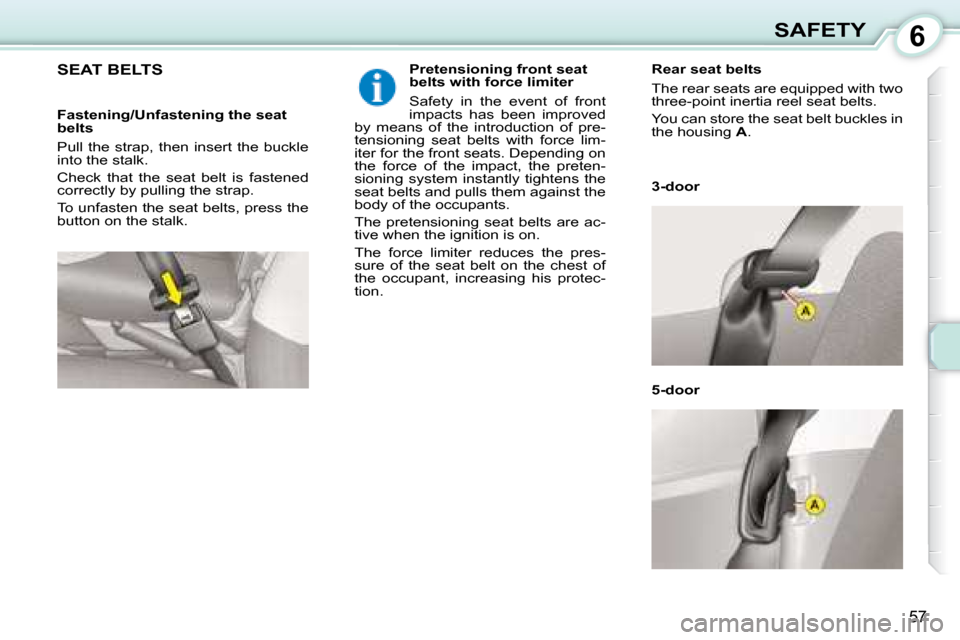
6
57
SAFETY
SEAT BELTS Pretensioning front seat
belts with force limiter
Safety in the event of front
impacts has been improved
by means of the introduction of pre-
tensioning seat belts with force lim-
iter for the front seats. Depending on
the force of the impact, the preten-
sioning system instantly tightens the
seat belts and pulls them against the
body of the occupants.
The pretensioning seat belts are ac-
tive when the ignition is on.
The force limiter reduces the pres-
sure of the seat belt on the chest of
the occupant, increasing his protec-
tion. 3-door
5-door
Rear seat belts
The rear seats are equipped with two
three-point inertia reel seat belts.
You can store the seat belt buckles in
the housing
A .
Fastening/Unfastening the seat
belts
Pull the strap, then insert the buckle
into the stalk.
Check that the seat belt is fastened
correctly by pulling the strap.
To unfasten the seat belts, press the
button on the stalk.
Page 62 of 97
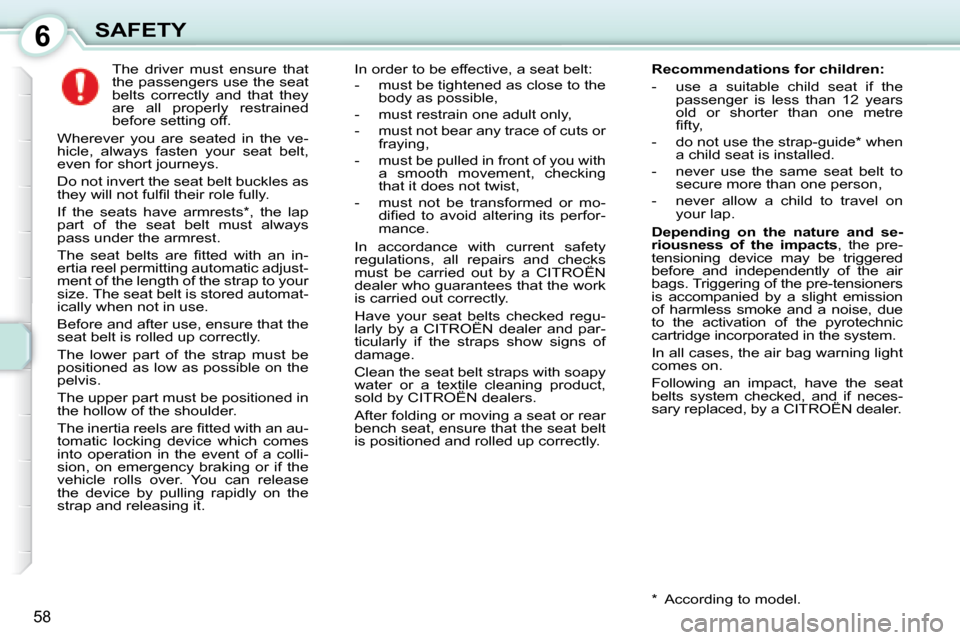
6
58
SAFETY The driver must ensure that
the passengers use the seat
belts correctly and that they
are all properly restrained
before setting off.
Wherever you are seated in the ve-
hicle, always fasten your seat belt,
even for short journeys.
Do not invert the seat belt buckles as
�t�h�e�y� �w�i�l�l� �n�o�t� �f�u�l�fi� �l� �t�h�e�i�r� �r�o�l�e� �f�u�l�l�y�.�
If the seats have armrests * , the lap
part of the seat belt must always
pass under the armrest.
� �T�h�e� �s�e�a�t� �b�e�l�t�s� �a�r�e� �fi� �t�t�e�d� �w�i�t�h� �a�n� �i�n�-
ertia reel permitting automatic adjust-
ment of the length of the strap to your
size. The seat belt is stored automat-
ically when not in use.
Before and after use, ensure that the
seat belt is rolled up correctly.
The lower part of the strap must be
positioned as low as possible on the
pelvis.
The upper part must be positioned in
the hollow of the shoulder.
� �T�h�e� �i�n�e�r�t�i�a� �r�e�e�l�s� �a�r�e� �fi� �t�t�e�d� �w�i�t�h� �a�n� �a�u�-
tomatic locking device which comes
into operation in the event of a colli-
sion, on emergency braking or if the
vehicle rolls over. You can release
the device by pulling rapidly on the
strap and releasing it. In order to be effective, a seat belt:
- must be tightened as close to the
body as possible,
- must restrain one adult only,
- must not bear any trace of cuts or fraying,
- must be pulled in front of you with a smooth movement, checking
that it does not twist,
- must not be transformed or mo- �d�i�fi� �e�d� �t�o� �a�v�o�i�d� �a�l�t�e�r�i�n�g� �i�t�s� �p�e�r�f�o�r�-
mance.
In accordance with current safety
regulations, all repairs and checks
must be carried out by a CITROËN
dealer who guarantees that the work
is carried out correctly.
Have your seat belts checked regu-
larly by a CITROËN dealer and par-
ticularly if the straps show signs of
damage.
Clean the seat belt straps with soapy
water or a textile cleaning product,
sold by CITROËN dealers.
After folding or moving a seat or rear
bench seat, ensure that the seat belt
is positioned and rolled up correctly. Recommendations for children:
- use a suitable child seat if the
passenger is less than 12 years
old or shorter than one metre
�fi� �f�t�y�,�
- do not use the strap-guide * when a child seat is installed.
- never use the same seat belt to secure more than one person,
- never allow a child to travel on your lap.
Depending on the nature and se-
riousness of the impacts , the pre-
tensioning device may be triggered
before and independently of the air
bags. Triggering of the pre-tensioners
is accompanied by a slight emission
of harmless smoke and a noise, due
to the activation of the pyrotechnic
cartridge incorporated in the system.
In all cases, the air bag warning light
comes on.
Following an impact, have the seat
belts system checked, and if neces-
sary replaced, by a CITROËN dealer.
* According to model.
Page 63 of 97
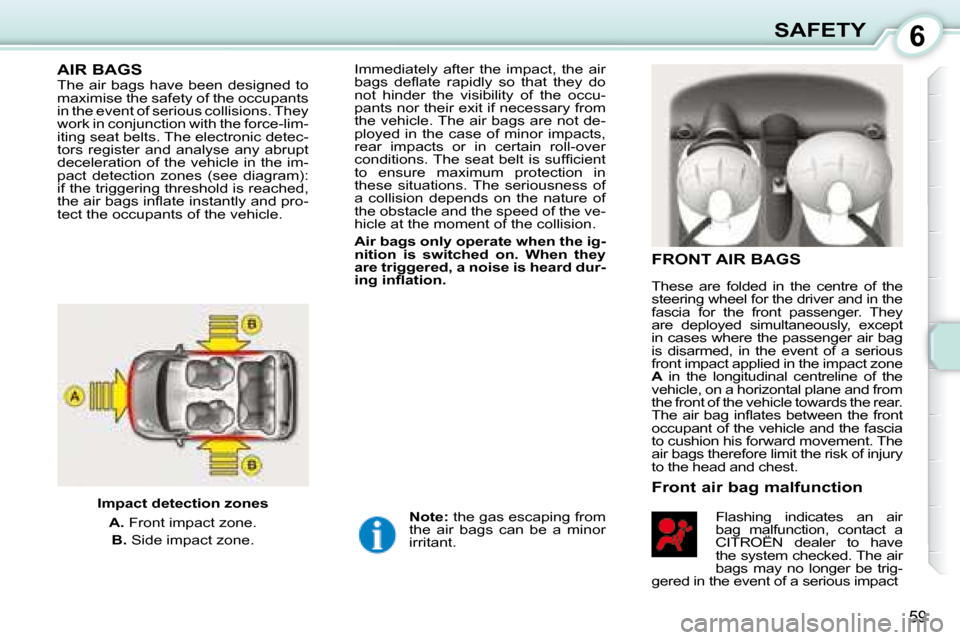
6
59
SAFETY
AIR BAGS The air bags have been designed to
maximise the safety of the occupants
in the event of serious collisions. They
work in conjunction with the force-lim-
iting seat belts. The electronic detec-
tors register and analyse any abrupt
deceleration of the vehicle in the im-
pact detection zones (see diagram):
if the triggering threshold is reached,
�t�h�e� �a�i�r� �b�a�g�s� �i�n�fl� �a�t�e� �i�n�s�t�a�n�t�l�y� �a�n�d� �p�r�o�-
tect the occupants of the vehicle.
FRONT AIR BAGS
These are folded in the centre of the
steering wheel for the driver and in the
fascia for the front passenger. They
are deployed simultaneously, except
in cases where the passenger air bag
is disarmed, in the event of a serious
front impact applied in the impact zone
A in the longitudinal centreline of the
vehicle, on a horizontal plane and from
the front of the vehicle towards the rear.
�T�h�e� �a�i�r� �b�a�g� �i�n�fl� �a�t�e�s� �b�e�t�w�e�e�n� �t�h�e� �f�r�o�n�t�
occupant of the vehicle and the fascia
to cushion his forward movement. The
air bags therefore limit the risk of injury
to the head and chest.
Front air bag malfunction
Flashing indicates an air
bag malfunction, contact a
CITROËN dealer to have
the system checked. The air
bags may no longer be trig-
gered in the event of a serious impact
Note: the gas escaping from
the air bags can be a minor
irritant.
Immediately after the impact, the air
�b�a�g�s� �d�e�fl� �a�t�e� �r�a�p�i�d�l�y� �s�o� �t�h�a�t� �t�h�e�y� �d�o�
not hinder the visibility of the occu-
pants nor their exit if necessary from
the vehicle. The air bags are not de-
ployed in the case of minor impacts,
rear impacts or in certain roll-over
�c�o�n�d�i�t�i�o�n�s�.� �T�h�e� �s�e�a�t� �b�e�l�t� �i�s� �s�u�f�fi� �c�i�e�n�t�
to ensure maximum protection in
these situations. The seriousness of
a collision depends on the nature of
the obstacle and the speed of the ve-
hicle at the moment of the collision.
Air bags only operate when the ig-
nition is switched on. When they
are triggered, a noise is heard dur-
�i�n�g� �i�n�fl� �a�t�i�o�n�.
Impact detection zones
A. Front impact zone.
B. Side impact zone.
Page 64 of 97
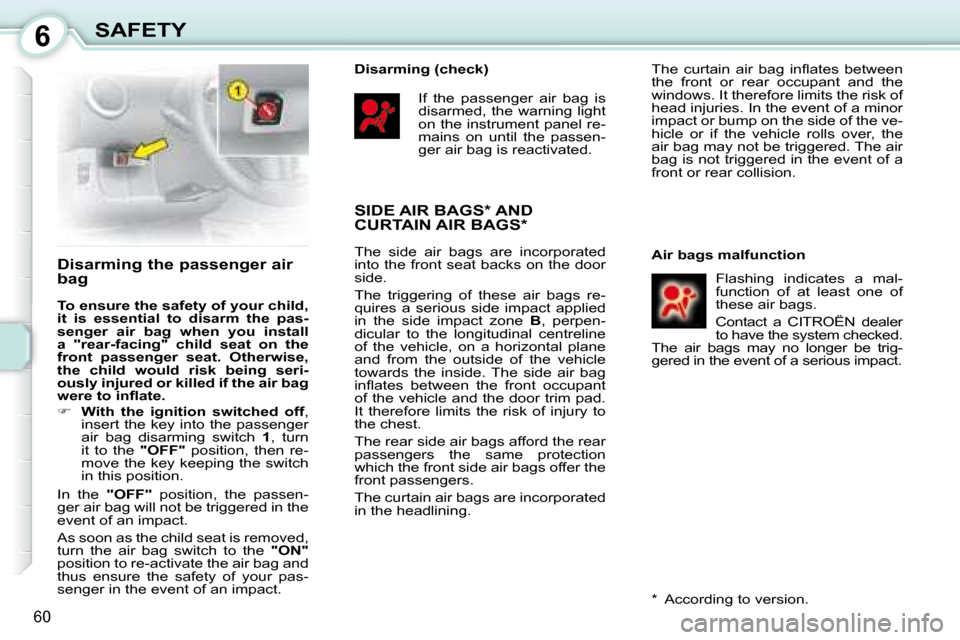
6
60
SAFETY
Disarming the passenger air
bag
To ensure the safety of your child,
it is essential to disarm the pas-
senger air bag when you install
a "rear-facing" child seat on the
front passenger seat. Otherwise,
the child would risk being seri-
ously injured or killed if the air bag
�w�e�r�e� �t�o� �i�n�fl� �a�t�e�.
� With the ignition switched off ,
insert the key into the passenger
air bag disarming switch 1 , turn
it to the "OFF" position, then re-
move the key keeping the switch
in this position.
In the "OFF" position, the passen-
ger air bag will not be triggered in the
event of an impact.
As soon as the child seat is removed,
turn the air bag switch to the "ON"
position to re-activate the air bag and
thus ensure the safety of your pas-
senger in the event of an impact. If the passenger air bag is
disarmed, the warning light
on the instrument panel re-
mains on until the passen-
ger air bag is reactivated.
� �T�h�e� �c�u�r�t�a�i�n� �a�i�r� �b�a�g� �i�n�fl� �a�t�e�s� �b�e�t�w�e�e�n�
the front or rear occupant and the
windows. It therefore limits the risk of
head injuries. In the event of a minor
impact or bump on the side of the ve-
hicle or if the vehicle rolls over, the
air bag may not be triggered. The air
bag is not triggered in the event of a
front or rear collision.
Flashing indicates a mal-
function of at least one of
these air bags.
Contact a CITROËN dealer
to have the system checked.
The air bags may no longer be trig-
gered in the event of a serious impact.
Disarming (check)
Air bags malfunction
* According to version.
SIDE AIR BAGS * AND CURTAIN AIR BAGS *
The side air bags are incorporated
into the front seat backs on the door
side.
The triggering of these air bags re-
quires a serious side impact applied
in the side impact zone B , perpen-
dicular to the longitudinal centreline
of the vehicle, on a horizontal plane
and from the outside of the vehicle
towards the inside. The side air bag
�i�n�fl� �a�t�e�s� �b�e�t�w�e�e�n� �t�h�e� �f�r�o�n�t� �o�c�c�u�p�a�n�t�
of the vehicle and the door trim pad.
It therefore limits the risk of injury to
the chest.
The rear side air bags afford the rear
passengers the same protection
which the front side air bags offer the
front passengers.
The curtain air bags are incorporated
in the headlining.
Page 65 of 97
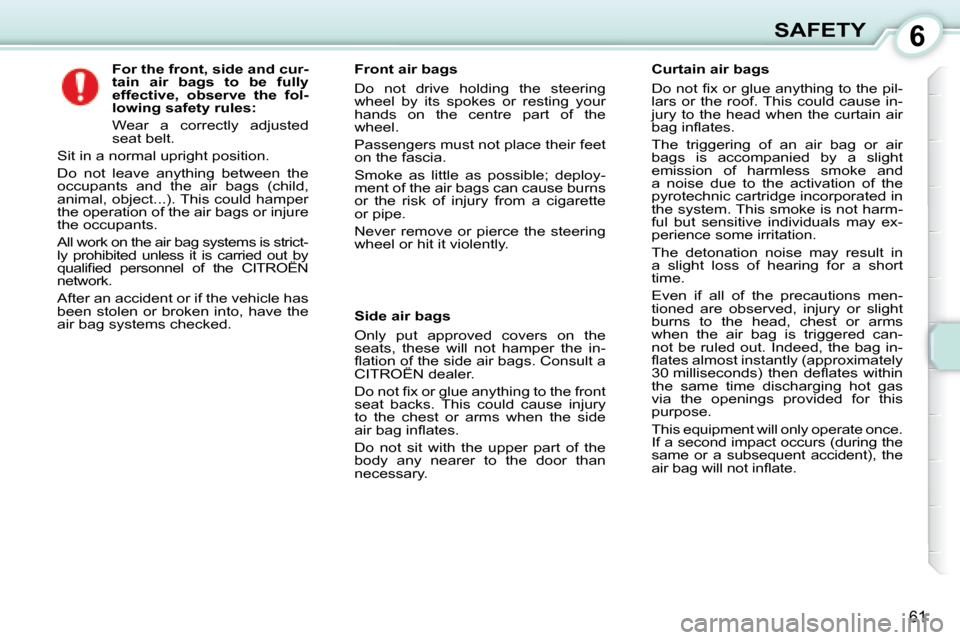
6
61
SAFETY
For the front, side and cur-
tain air bags to be fully
effective, observe the fol-
lowing safety rules:
Wear a correctly adjusted
seat belt.
Sit in a normal upright position.
Do not leave anything between the
occupants and the air bags (child,
animal, object...). This could hamper
the operation of the air bags or injure
the occupants.
All work on the air bag systems is strict-
ly prohibited unless it is carried out by
�q�u�a�l�i�fi� �e�d� �p�e�r�s�o�n�n�e�l� �o�f� �t�h�e� � �C�I�T�R�O��N� �
network.
After an accident or if the vehicle has
been stolen or broken into, have the
air bag systems checked. Front air bags
Do not drive holding the steering
wheel by its spokes or resting your
hands on the centre part of the
wheel.
Passengers must not place their feet
on the fascia.
Smoke as little as possible; deploy-
ment of the air bags can cause burns
or the risk of injury from a cigarette
or pipe.
Never remove or pierce the steering
wheel or hit it violently.
Curtain air bags
� �D�o� �n�o�t� �fi� �x� �o�r� �g�l�u�e� �a�n�y�t�h�i�n�g� �t�o� �t�h�e� �p�i�l�-
lars or the roof. This could cause in-
jury to the head when the curtain air
�b�a�g� �i�n�fl� �a�t�e�s�.�
The triggering of an air bag or air
bags is accompanied by a slight
emission of harmless smoke and
a noise due to the activation of the
pyrotechnic cartridge incorporated in
the system. This smoke is not harm-
ful but sensitive individuals may ex-
perience some irritation.
The detonation noise may result in
a slight loss of hearing for a short
time.
Even if all of the precautions men-
tioned are observed, injury or slight
burns to the head, chest or arms
when the air bag is triggered can-
not be ruled out. Indeed, the bag in-
�fl� �a�t�e�s� �a�l�m�o�s�t� �i�n�s�t�a�n�t�l�y� �(�a�p�p�r�o�x�i�m�a�t�e�l�y�
�3�0� �m�i�l�l�i�s�e�c�o�n�d�s�)� �t�h�e�n� �d�e�fl� �a�t�e�s� �w�i�t�h�i�n�
the same time discharging hot gas
via the openings provided for this
purpose.
This equipment will only operate once.
If a second impact occurs (during the
same or a subsequent accident), the
�a�i�r� �b�a�g� �w�i�l�l� �n�o�t� �i�n�fl� �a�t�e�.� � �
Side air bags
Only put approved covers on the
seats, these will not hamper the in-
�fl� �a�t�i�o�n� �o�f� �t�h�e� �s�i�d�e� �a�i�r� �b�a�g�s�.� � �C�o�n�s�u�l�t� �a�
CITROËN dealer.
� �D�o� �n�o�t� �fi� �x� �o�r� �g�l�u�e� �a�n�y�t�h�i�n�g� �t�o� �t�h�e� �f�r�o�n�t�
seat backs. This could cause injury
to the chest or arms when the side
�a�i�r� �b�a�g� �i�n�fl� �a�t�e�s�.�
Do not sit with the upper part of the
body any nearer to the door than
necessary.
Page 66 of 97
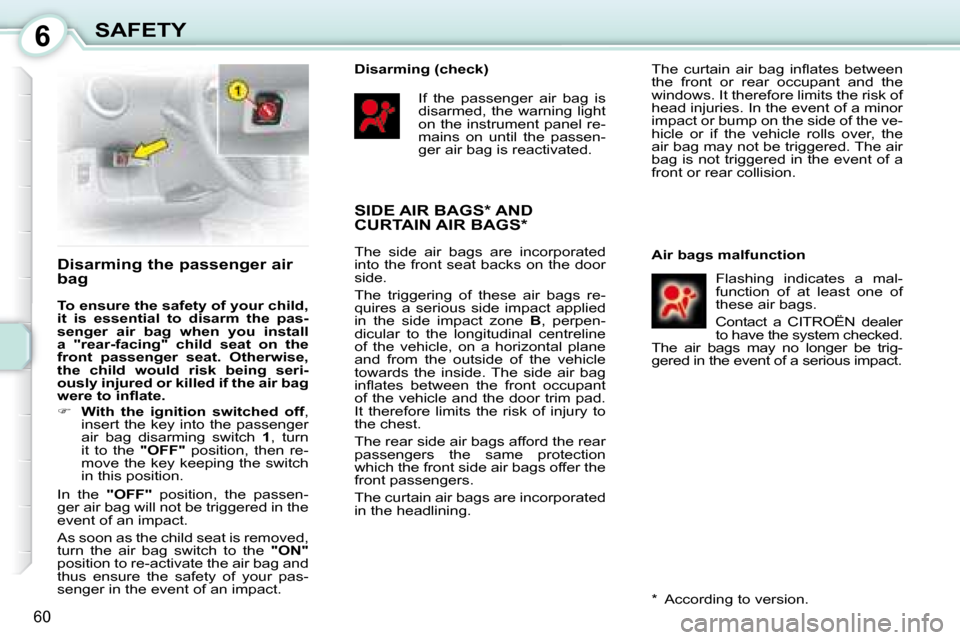
6
60
SAFETY
Disarming the passenger air
bag
To ensure the safety of your child,
it is essential to disarm the pas-
senger air bag when you install
a "rear-facing" child seat on the
front passenger seat. Otherwise,
the child would risk being seri-
ously injured or killed if the air bag
�w�e�r�e� �t�o� �i�n�fl� �a�t�e�.
� With the ignition switched off ,
insert the key into the passenger
air bag disarming switch 1 , turn
it to the "OFF" position, then re-
move the key keeping the switch
in this position.
In the "OFF" position, the passen-
ger air bag will not be triggered in the
event of an impact.
As soon as the child seat is removed,
turn the air bag switch to the "ON"
position to re-activate the air bag and
thus ensure the safety of your pas-
senger in the event of an impact. If the passenger air bag is
disarmed, the warning light
on the instrument panel re-
mains on until the passen-
ger air bag is reactivated.
� �T�h�e� �c�u�r�t�a�i�n� �a�i�r� �b�a�g� �i�n�fl� �a�t�e�s� �b�e�t�w�e�e�n�
the front or rear occupant and the
windows. It therefore limits the risk of
head injuries. In the event of a minor
impact or bump on the side of the ve-
hicle or if the vehicle rolls over, the
air bag may not be triggered. The air
bag is not triggered in the event of a
front or rear collision.
Flashing indicates a mal-
function of at least one of
these air bags.
Contact a CITROËN dealer
to have the system checked.
The air bags may no longer be trig-
gered in the event of a serious impact.
Disarming (check)
Air bags malfunction
* According to version.
SIDE AIR BAGS * AND CURTAIN AIR BAGS *
The side air bags are incorporated
into the front seat backs on the door
side.
The triggering of these air bags re-
quires a serious side impact applied
in the side impact zone B , perpen-
dicular to the longitudinal centreline
of the vehicle, on a horizontal plane
and from the outside of the vehicle
towards the inside. The side air bag
�i�n�fl� �a�t�e�s� �b�e�t�w�e�e�n� �t�h�e� �f�r�o�n�t� �o�c�c�u�p�a�n�t�
of the vehicle and the door trim pad.
It therefore limits the risk of injury to
the chest.
The rear side air bags afford the rear
passengers the same protection
which the front side air bags offer the
front passengers.
The curtain air bags are incorporated
in the headlining.
Page 67 of 97
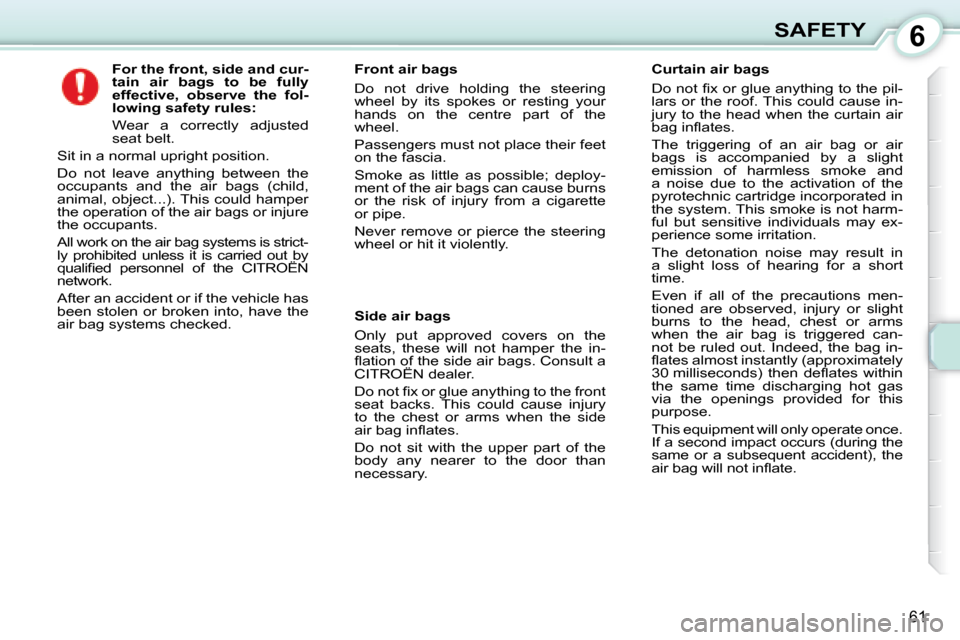
6
61
SAFETY
For the front, side and cur-
tain air bags to be fully
effective, observe the fol-
lowing safety rules:
Wear a correctly adjusted
seat belt.
Sit in a normal upright position.
Do not leave anything between the
occupants and the air bags (child,
animal, object...). This could hamper
the operation of the air bags or injure
the occupants.
All work on the air bag systems is strict-
ly prohibited unless it is carried out by
�q�u�a�l�i�fi� �e�d� �p�e�r�s�o�n�n�e�l� �o�f� �t�h�e� � �C�I�T�R�O��N� �
network.
After an accident or if the vehicle has
been stolen or broken into, have the
air bag systems checked. Front air bags
Do not drive holding the steering
wheel by its spokes or resting your
hands on the centre part of the
wheel.
Passengers must not place their feet
on the fascia.
Smoke as little as possible; deploy-
ment of the air bags can cause burns
or the risk of injury from a cigarette
or pipe.
Never remove or pierce the steering
wheel or hit it violently.
Curtain air bags
� �D�o� �n�o�t� �fi� �x� �o�r� �g�l�u�e� �a�n�y�t�h�i�n�g� �t�o� �t�h�e� �p�i�l�-
lars or the roof. This could cause in-
jury to the head when the curtain air
�b�a�g� �i�n�fl� �a�t�e�s�.�
The triggering of an air bag or air
bags is accompanied by a slight
emission of harmless smoke and
a noise due to the activation of the
pyrotechnic cartridge incorporated in
the system. This smoke is not harm-
ful but sensitive individuals may ex-
perience some irritation.
The detonation noise may result in
a slight loss of hearing for a short
time.
Even if all of the precautions men-
tioned are observed, injury or slight
burns to the head, chest or arms
when the air bag is triggered can-
not be ruled out. Indeed, the bag in-
�fl� �a�t�e�s� �a�l�m�o�s�t� �i�n�s�t�a�n�t�l�y� �(�a�p�p�r�o�x�i�m�a�t�e�l�y�
�3�0� �m�i�l�l�i�s�e�c�o�n�d�s�)� �t�h�e�n� �d�e�fl� �a�t�e�s� �w�i�t�h�i�n�
the same time discharging hot gas
via the openings provided for this
purpose.
This equipment will only operate once.
If a second impact occurs (during the
same or a subsequent accident), the
�a�i�r� �b�a�g� �w�i�l�l� �n�o�t� �i�n�fl� �a�t�e�.� � �
Side air bags
Only put approved covers on the
seats, these will not hamper the in-
�fl� �a�t�i�o�n� �o�f� �t�h�e� �s�i�d�e� �a�i�r� �b�a�g�s�.� � �C�o�n�s�u�l�t� �a�
CITROËN dealer.
� �D�o� �n�o�t� �fi� �x� �o�r� �g�l�u�e� �a�n�y�t�h�i�n�g� �t�o� �t�h�e� �f�r�o�n�t�
seat backs. This could cause injury
to the chest or arms when the side
�a�i�r� �b�a�g� �i�n�fl� �a�t�e�s�.�
Do not sit with the upper part of the
body any nearer to the door than
necessary.
Page 68 of 97
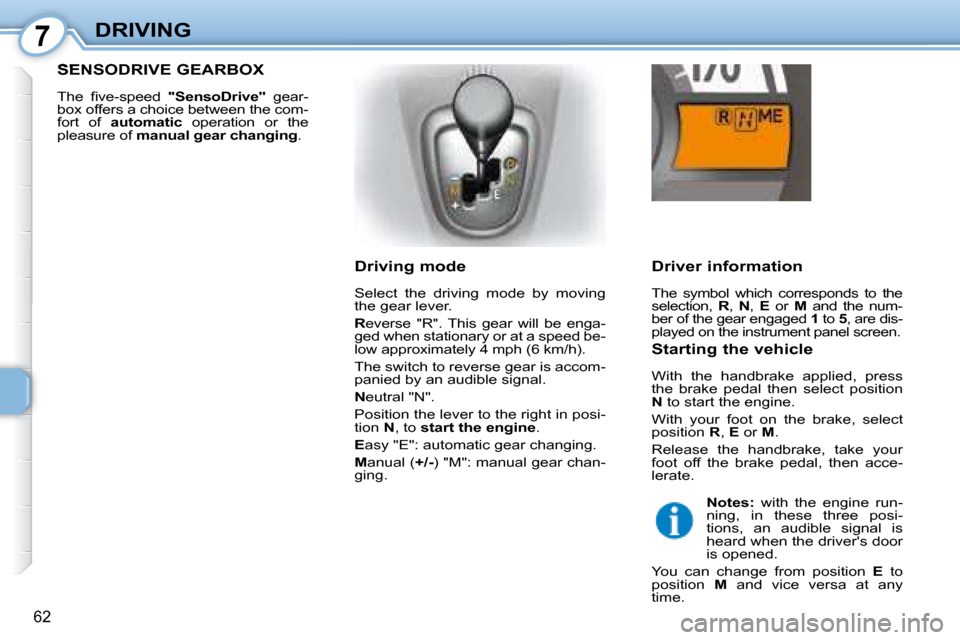
7
62
DRIVING Driver information
The symbol which corresponds to the
selection, R , N , E or M and the num-
ber of the gear engaged 1 to 5 , are dis-
played on the instrument panel screen.
SENSODRIVE GEARBOX
� �T�h�e� �fi� �v�e�-�s�p�e�e�d� � "SensoDrive" gear-
box offers a choice between the com-
fort of automatic operation or the
pleasure of manual gear changing .
Driving mode
� �S�e�l�e�c�t� �t�h�e� �d�r�i�v�i�n�g� �m�o�d�e� �b�y� �m�o�v�i�n�g�
�t�h�e� �g�e�a�r� �l�e�v�e�r�.�
R � �e�v�e�r�s�e� �"�R�"�.� �T�h�i�s� �g�e�a�r� �w�i�l�l� �b�e� �e�n�g�a�-
ged when stationary or at a speed be-
low approximately 4 mph (6 km/h).
� �T�h�e� �s�w�i�t�c�h� �t�o� �r�e�v�e�r�s�e� �g�e�a�r� �i�s� �a�c�c�o�m�-
panied by an audible signal.
N � �e�u�t�r�a�l� �"�N�"�.�
� �P�o�s�i�t�i�o�n� �t�h�e� �l�e�v�e�r� �t�o� �t�h�e� �r�i�g�h�t� �i�n� �p�o�s�i�-
tion N , to start the engine .
E � �a�s�y� �"�E�"�:� �a�u�t�o�m�a�t�i�c� �g�e�a�r� �c�h�a�n�g�i�n�g�.�
M anual ( +/-)� � �"�M�"�:� �m�a�n�u�a�l� �g�e�a�r� �c�h�a�n�-
ging. Starting the vehicle
With the handbrake applied, press
the brake pedal then select position
N to start the engine.
With your foot on the brake, select
position R , E or M .
� �R�e�l�e�a�s�e� �t�h�e� �h�a�n�d�b�r�a�k�e�,� �t�a�k�e� �y�o�u�r�
foot off the brake pedal, then acce-
lerate.
Notes: with the engine run-
ning, in these three posi-
tions, an audible signal is
�h�e�a�r�d� �w�h�e�n� �t�h�e� �d�r�i�v�e�r�'�s� �d�o�o�r�
is opened.
You can change from position E to
position M� � �a�n�d� �v�i�c�e� �v�e�r�s�a� �a�t� �a�n�y�
time.
Page 69 of 97
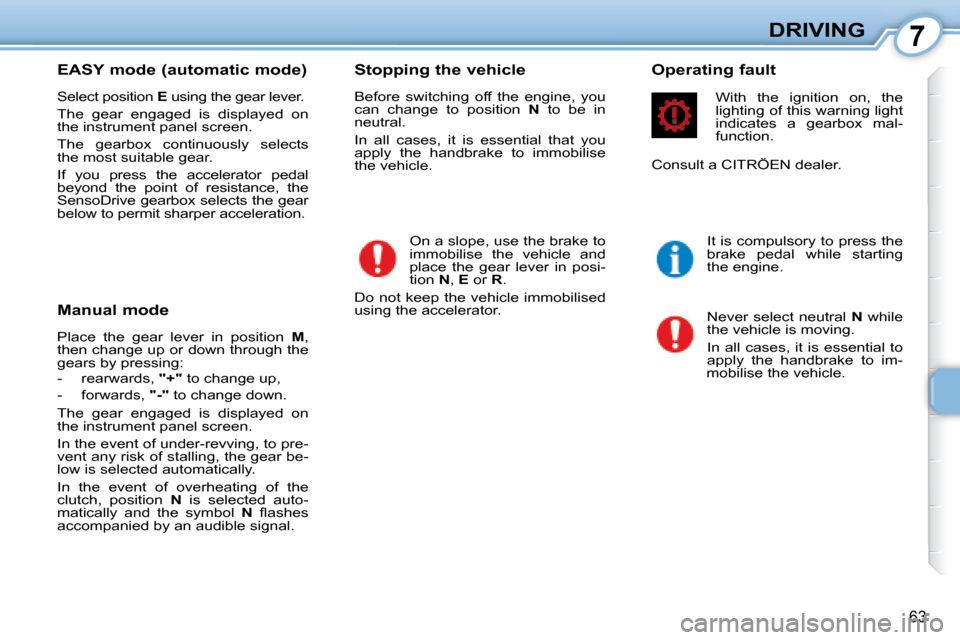
7
63
DRIVING
EASY mode (automatic mode)
Select position E� � �u�s�i�n�g� �t�h�e� �g�e�a�r� �l�e�v�e�r�.�
The gear engaged is displayed on
the instrument panel screen.
The gearbox continuously selects
the most suitable gear.
If you press the accelerator pedal
beyond the point of resistance, the
�S�e�n�s�o�D�r�i�v�e� �g�e�a�r�b�o�x� �s�e�l�e�c�t�s� �t�h�e� �g�e�a�r�
below to permit sharper acceleration.
Manual mode
� �P�l�a�c�e� �t�h�e� �g�e�a�r� �l�e�v�e�r� �i�n� �p�o�s�i�t�i�o�n� � M ,
then change up or down through the
�g�e�a�r�s� �b�y� �p�r�e�s�s�i�n�g�:�
- rearwards, "+" to change up,
- forwards, "-" to change down.
The gear engaged is displayed on
the instrument panel screen.
� �I�n� �t�h�e� �e�v�e�n�t� �o�f� �u�n�d�e�r�-�r�e�v�v�i�n�g�,� �t�o� �p�r�e�-
�v�e�n�t� �a�n�y� �r�i�s�k� �o�f� �s�t�a�l�l�i�n�g�,� �t�h�e� �g�e�a�r� �b�e�-
low is selected automatically.
� �I�n� �t�h�e� �e�v�e�n�t� �o�f� �o�v�e�r�h�e�a�t�i�n�g� �o�f� �t�h�e�
clutch, position N is selected auto-
matically and the symbol N� � �fl� �a�s�h�e�s�
accompanied by an audible signal. Operating fault
Stopping the vehicle
Before switching off the engine, you
can change to position N to be in
neutral.
In all cases, it is essential that you
apply the handbrake to immobilise
�t�h�e� �v�e�h�i�c�l�e�.� With the ignition on, the
lighting of this warning light
indicates a gearbox mal-
function.
On a slope, use the brake to
�i�m�m�o�b�i�l�i�s�e� �t�h�e� �v�e�h�i�c�l�e� �a�n�d�
�p�l�a�c�e� �t�h�e� �g�e�a�r� �l�e�v�e�r� �i�n� �p�o�s�i�-
tion N , E or R .
� �D�o� �n�o�t� �k�e�e�p� �t�h�e� �v�e�h�i�c�l�e� �i�m�m�o�b�i�l�i�s�e�d�
using the accelerator. It is compulsory to press the
brake pedal while starting
the engine.
� �N�e�v�e�r� �s�e�l�e�c�t� �n�e�u�t�r�a�l� �
N while
�t�h�e� �v�e�h�i�c�l�e� �i�s� �m�o�v�i�n�g�.�
In all cases, it is essential to
apply the handbrake to im-
�m�o�b�i�l�i�s�e� �t�h�e� �v�e�h�i�c�l�e�.� �
� � �C�o�n�s�u�l�t� �a� �C�I�T�R�Ö�E�N� �d�e�a�l�e�r�.� �
Page 70 of 97
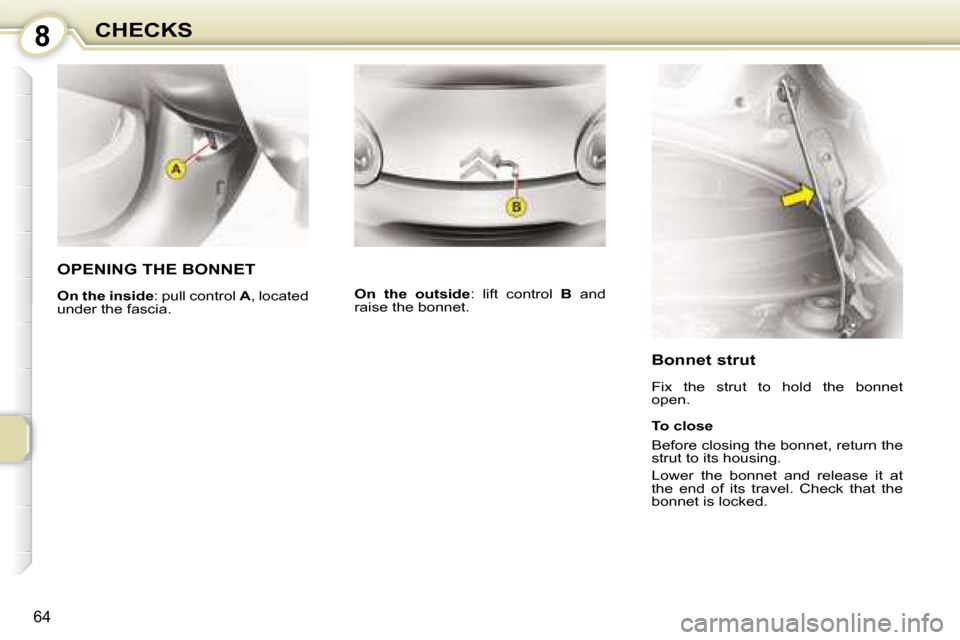
8
64
CHECKS
OPENING THE BONNET
On the inside : pull control A , located
under the fascia.
On the outside : lift control B and
raise the bonnet.
Bonnet strut
Fix the strut to hold the bonnet
open.
To close
Before closing the bonnet, return the
strut to its housing.
Lower the bonnet and release it at
the end of its travel. Check that the
bonnet is locked.